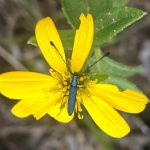Cassava: The Answer to Food Insecurity and Economic Development for Marange Community.
Rural communities in Zimbabwe have been growing cassava on the side-lines of crops such as maize, groundnuts and potatoes. Little do they know that cassava is a valuable cash crop, with a flourishing market when grown on a larger scale.
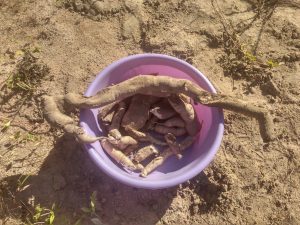
Cassava is the second most important source of carbohydrates in sub-Saharan African, after maize, and is eaten by around 500 million people every day, according to the UN Food and Agriculture Organization. Globally, 280 million tons are produced every year, with half the supply coming from Africa. Uganda one of the largest African producers, produces 5.4 million tons of cassava every year.
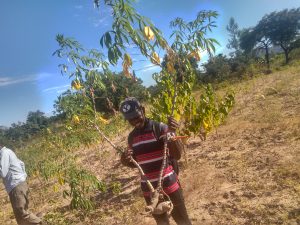
As climate change and global warming keep presenting obstacles to sustainable food production cassava might be the answer Zimbabwe needs especially communities in Agriculture Region 4 and 5. In the face of unreliable rainfall, cassava is known for performing well in drought-prone areas and on poor soils and is thus considered one of the most productive tropical crops on marginal lands. In seasonally dry and semi-arid environments such as the Region 4 and 5 of Zimbabwe which receives less than 700mm of rainfall, cassava will thrive without any problems. It has been dubbed an ‘insurance’ crop as it provides food in drought periods when most crops would have failed.
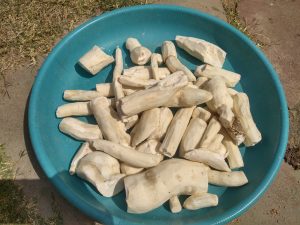
As an organisation that seeks for ways to improve food security and nutrition, Environmental Buddies Zimbabwe has been working in Marange Community to achieve sustainable Development Goal 2 of reducing hunger. Marange is a Communal area located in Manicaland Province of Zimbabwe. Marange is in Natural Region V which is characterized by worst agronomic climate in Zimbabwe. The region receives annual rainfall of about 650mm and is erratic. Temperatures can reach highs of 35 degrees celsius during most part of the year. These climatic conditions make it difficult for any meaningful crop production worsening the livelihoods and food security and nutrition situation in the area. Living standards in this place have significantly deteriorated since the 1990s, as most households failed to re-build after the 1991-1992 drought. Climate change impacts have further worsened the situation with most families living in abject poverty and on less than US$1 per day. This situation has resulted in over-reliance on forest resources. Rampant cutting down of trees for livelihoods purposes have increased land degradation rates and diminished sustainable livelihoods from forests.
Each year most families survive on food parcels from both local (Ministry of Primary and Secondary Education Feeding program) and international organisations such as GOAL, Plan International and World Food Program. One of EBZ’s objectives is to create a platform for participation of the underprivileged members of the society irrespective of gender and improve their well-being and reducing inequality gap. It is against this background that in December 2019, EBZ approached the Ministry of Lands, Agriculture, Water, Fisheries and Rural Resettlement to partner in the Marange Food Security Project.
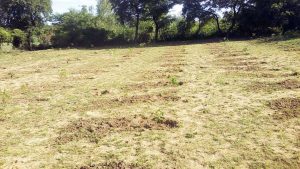
In January 2020, EBZ received cuttings from the Ministry of Lands, Agriculture, Water, Fisheries and Rural Resettlement, Mazowe Nursery. Three personnel from the same Ministry, namely Tapuwa Goromondo, Monica Mabika and Georgina Mwaramba, travelled to Marange to demonstrate how to prepare the cuttings and planting them. A total of 650 cassava cuttings were planted at the EBZ offices in Marange as a pilot project, and 600 survived, an impressive 92% survival rate. For 18 months EBZ team (Mr. Tafadzwa Mudefi, Mr. Frank Rabiwa, Ms Linda Muteeri, and Mr. Clifford Chatima) and community members watered, weeded and controlled pests such as termites. The experience provided a learning curve for the Marange community, that cassava can be grown as a major crop such as maize and other small grains and that it’s relatively undemanding, and thrives on poor and even tired soils, where few other crops will grow.
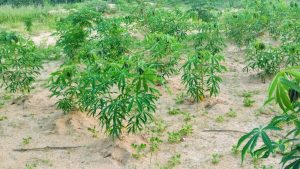
In April 2021, the cassava was harvested for the first time and 5 plants produced 10kg of cassava, an average of 2kgs/plant. Traditionally cassava is eaten as a breakfast dish served with tea and the EBZ team shared the first fruits at breakfast together with mealies, groundnuts and cow peas.
At the moment, EBZ has started producing their own cassava cuttings which will be ready to be planted during the 2021-2022. The target is 2000 cassava cuttings. Community members especially in Ward 23 will benefit immensely from this project.
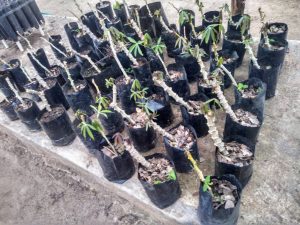
The plan is to recruit families who will each get 20 cuttings. Later they will be trained to grow their own cutting and in value addition. As the project gains momentum EBZ will continue to engage the Ministry and other stakeholders so that they help with identifying both local and export markets for the Marange Cassava. Food security at a household level is the major objective, and in times of surplus, cassava will be sold to earn income for the families. Talk about killing four birds with one stone, in this case using cassava to ensure food security (SDG 2), create employment (SDG 8), reduce pressure on forest resources, (SGD 15) and reducing poverty level (SDG 1).
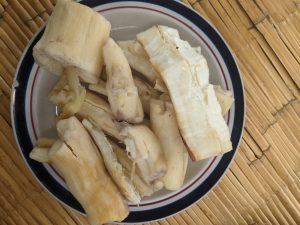
But there is only one problem, cassava has a short shelf life, when harvested, it has to be consumed immediately. This is a major drawback for any farmer who has 600 cassava plants. Moving forward, EBZ is looking at options to extend its shelf life by ‘value addition’. In other African countries, cassava is used to make cassava cheese balls, cassava fries and cassava flour.
Environmental Buddies Zimbabwe applauds the Ministry of Lands, Agriculture, Water, Fisheries and Rural Resettlement for fulfilling one of its mandates of, ‘developing strategies to ensure production and productivity of food and non-food agricultural products for self-sufficiency and security, economic growth as well as export.
- Empowering Marange’s Youth: Celebrating Africa Environment Day at Holy Ghost High School - March 14, 2024
- Sowing Seeds of Hope: Rejuvenating Chiadzwa’s Environment Through Tree Planting” - March 11, 2024
- 5 Years On. Growing Green: Cultivating a Sustainable Future For Macheke’s Children - March 11, 2024




